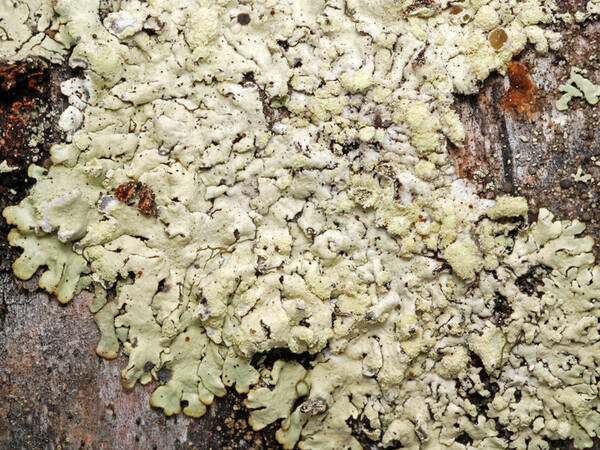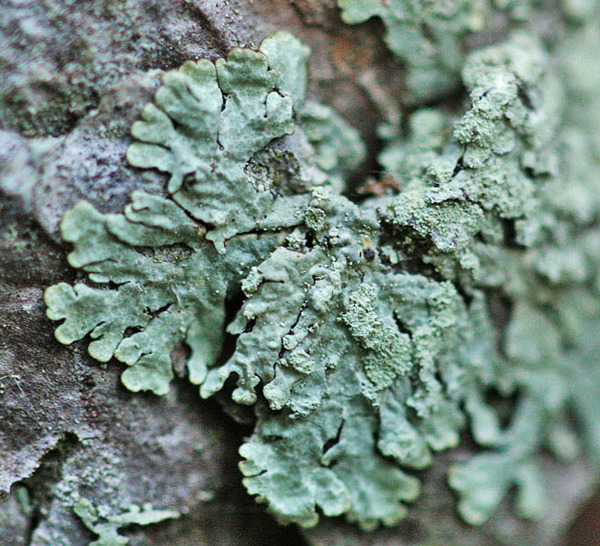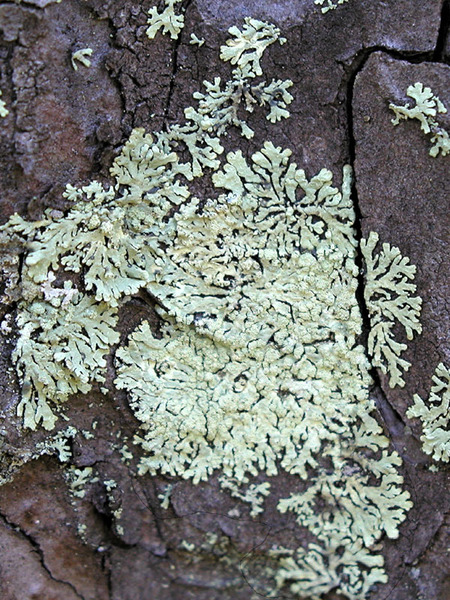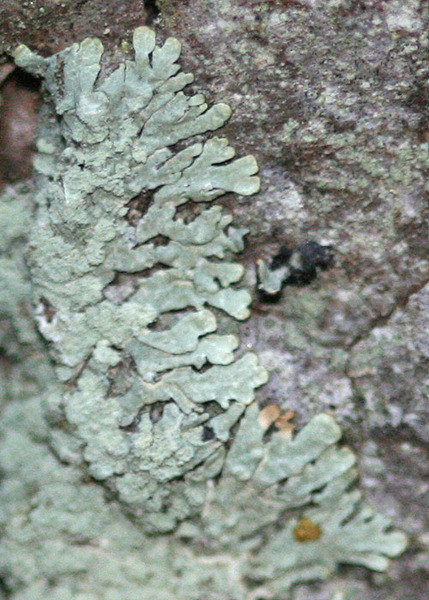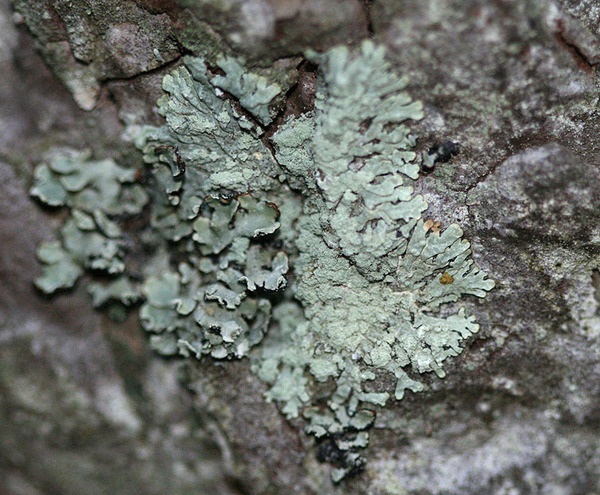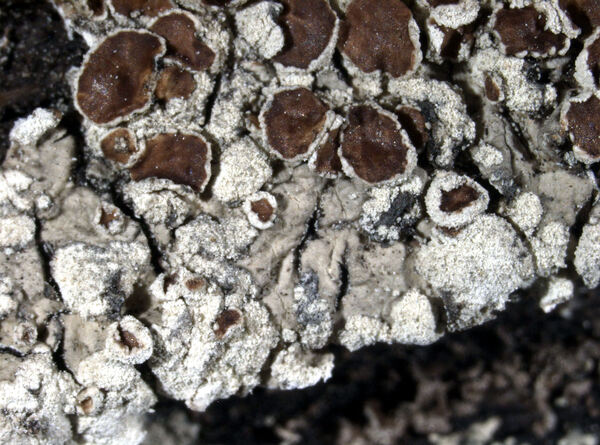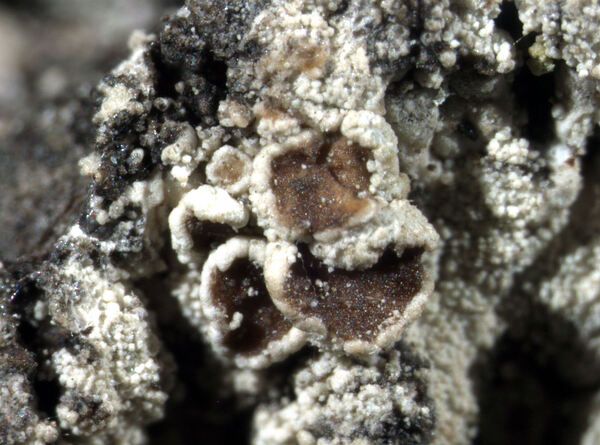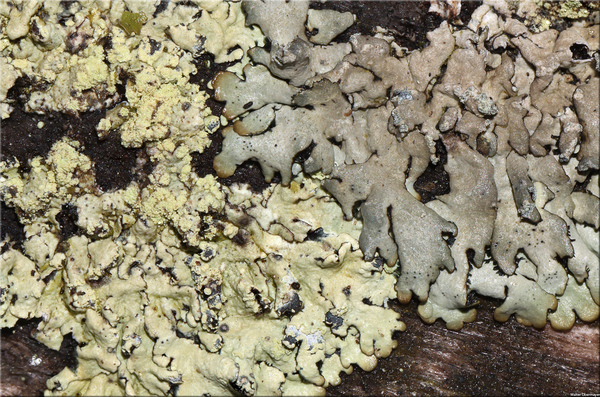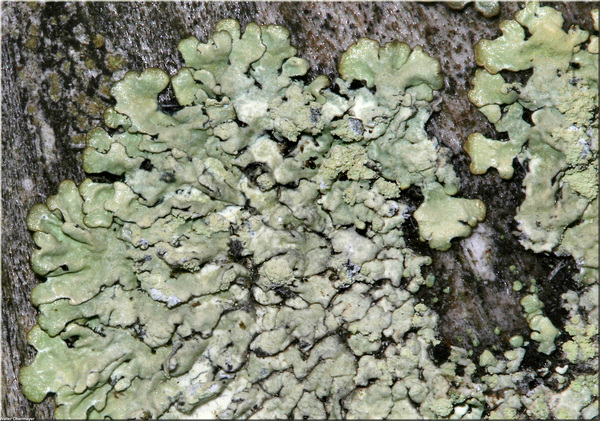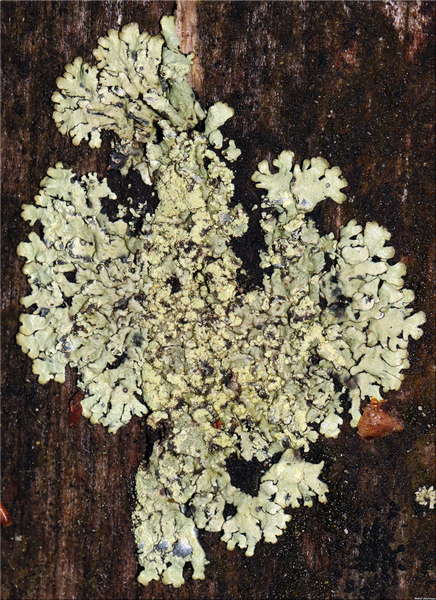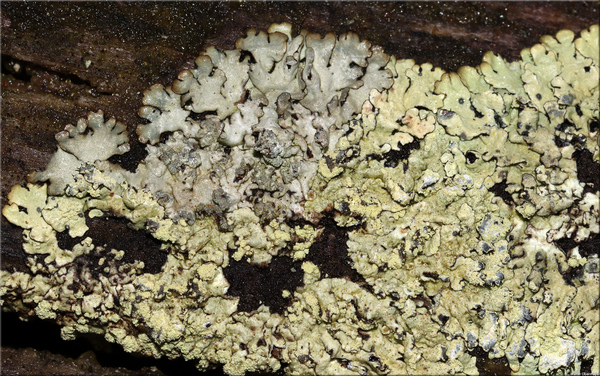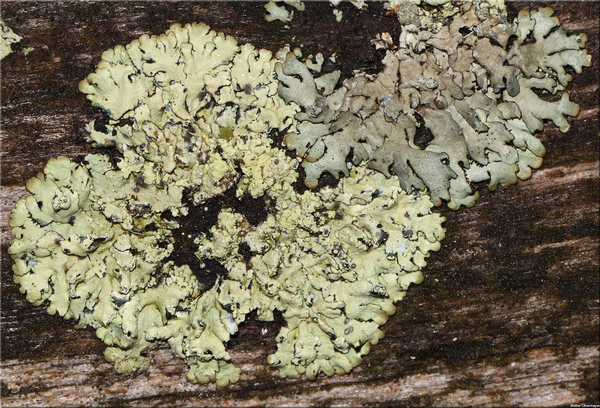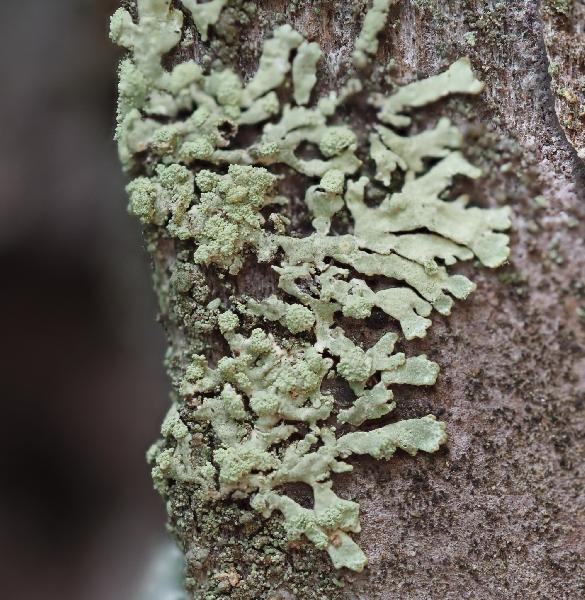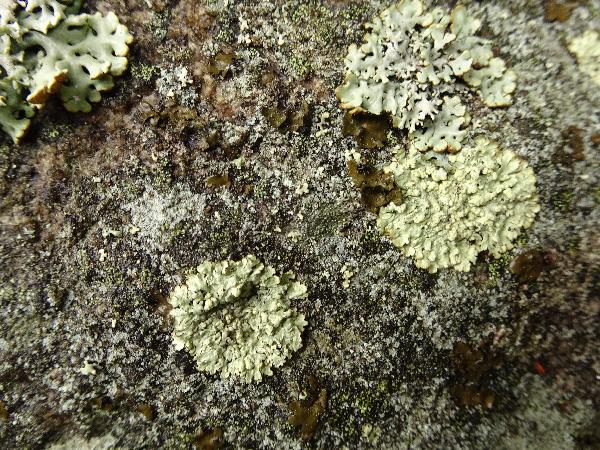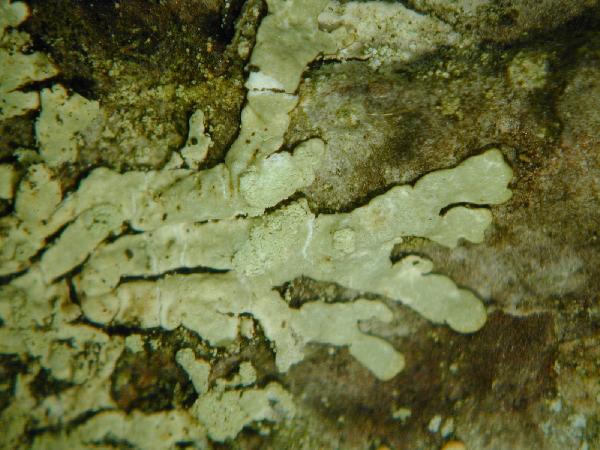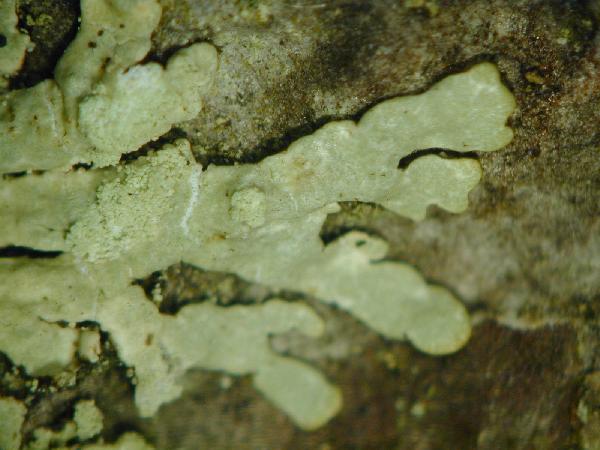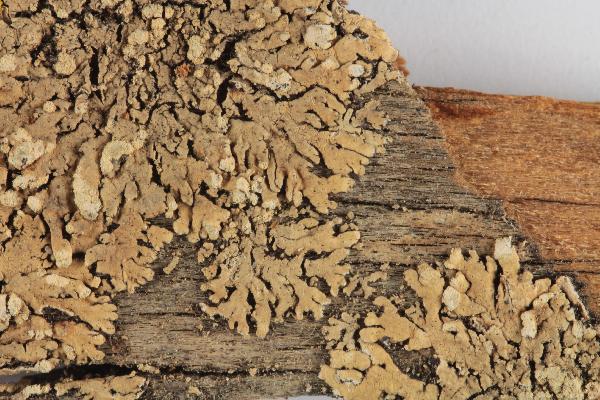Parmeliopsis ambigua (Hoffm.) Nyl.
Syn. Meth. Lich., 2: 54, 1863. Basionym: Squamaria ambigua Hoffm. - Descr. Pl. Cl. Crypt., 2, 24: 56, 1794.
Synonyms: Foraminella ambigua (Hoffm.) S.L.F. Mey.; Imbricaria diffusa auct.; Parmelia ambigua (Hoffm.) Ach.; Parmelia diffusa auct. non (Hoffm.) Sandst.; Parmelia diffusa var. ochromatica Wallr.; Parmelia subsoredians Nyl.; Parmeliopsis diffusa auct.; Parmeliopsis subsoredians (Nyl.) Nyl.
Distribution: N - Frl (Stofer 2006, Tretiach & Molaro 2007, Tomasi 2007), Ven (Nimis 1994, Nascimbene & Caniglia 1997, 2000b, 2002c, 2003c, Caniglia & al. 1999, Nascimbene 2005c, 2008, 2008c, 2011, Nascimbene & al. 2006e, 2009c, 2013b, Nascimbene & Marini 2007, Brackel 2013), TAA (Nascimbene & Caniglia 2000b, 2002c, Caniglia & al. 2002, Nascimbene 2003, 2005b, 2006b, 2006c, 2008b, 2014, Gottardini & al. 2004, Nascimbene & al. 2005, 2006, 2006e, 2007b, 2008c, 2009, 2010, 2014, Stofer 2006, 2022, Thor & Nascimbene 2007, Lang 2009, Brackel 2013, Nascimbene & Marini 2015, Nimis & al. 2015, Trindade & al. 2021), Lomb (Rivellini 1994, Alessio & al. 1995, Arosio & Rinaldi 1995, Zocchi & al. 1997, Arosio & al. 2003, Valcuvia & al. 2003, Dalle Vedove & al. 2004, Nascimbene & al. 2006e, Brackel 2013, Gheza & al. 2015, 2023, Gheza 2019, 2019b), Piem (Caniglia & al. 1992, Morisi & Sereno 1995, Arosio & al. 1998, Isocrono & Falletti 1999, Piervittori 2003, Isocrono & al. 2004, 2006, Morisi 2005, Isocrono & Piervittori 2008, Motiejunaitè & Grochowski 2014), VA (Borlandelli & al. 1996, Piervittori & Isocrono 1997, 1999, Valcuvia & al. 2000b, Piervittori & al. 2001, Revel & al. 2001, Ghiraldi 2003, Isocrono & al. 2005, Matteucci & al. 2008, 2008c, Isocrono & al. 2008, Loppi 2014, Lich. Ital. Exs. 64: Isocrono & al. 2022), Emil (Tretiach & al. 2008, Fariselli & al. 2020), Lig (Brunialti & al. 1999, Giordani & al. 2002, 2025, Brunialti & Giordani 2003, Giordani 2006, Watson 2014, Ravera & al. 2022b). C - Tosc (Loppi & al. 1994, Tretiach & Nimis 1994, Benesperi & al. 2007, Tretiach & al. 2008, Benesperi 2011, Brackel 2015, Frati & Brunialti 2023), Marc (Nimis & Tretiach 1999), Umb (Ravera 1998, Ravera & al. 2006), Abr (Nimis & Tretiach 1999, Corona & al. 2016), Sar (Nöske 2000, Neuwirth 2018). S - Camp (Aprile & al. 2003b, Garofalo & al. 2010), Bas, Cal (Puntillo 1996, Incerti & Nimis 2006), Si (Grillo & Caniglia 2004, 2006).
Description: Thallus foliose, heteromerous, dorsiventral, very closely attached, forming orbicular, regular, up to 3(-6) cm wide rosettes that often coalesce to cover much wider surfaces. Lobes radiating, contiguous, flat, (0.3-)0.4-0.6(-1.3) mm wide, sublinear, irregularly dichotomously branched, greenish yellow, often pale brown at margins and lobe tips, dull in central parts, slightly shiny in apical parts, smooth, weakly maculate, with powdery, yellowish green soredia in well-delimited, circular, laminal soralia which sometimes coalesce into a continuous sorediate crust. Lower surface gradually darkening from a narrow, brown marginal zone to dark brown or black in the center, with sparse, usually simple rhizines. Upper cortex 10-20 µm thick, of tightly packed, anticlinally oriented hyphae, with a pored epicortex, the cell walls with isolichenan; medulla white; algal layer continuous; lower cortex of hyphae running parallel to the surface. Apothecia very rare, lecanorine, 1-2 mm across, with a brown disc and a sorediate thalline margin. Epithecium brown; hymenium and hypothecium colourless; paraphyses mostly simple. Asci 8-spored, clavate, Lecanora-type. Ascospores 1-celled. hyaline, ellipsoid, 6.5-11(-12) x (1.5-)2-3(-5) µm. Pycnidia rare, with richly branched, Psora-type conidiophores. Conidia thread-like, falcate, 12-18(-22) x 0.5-1 µm. Photobiont chlorococcoid. Spot tests: upper cortex K- or K+ (rarely) faintly yellow, C-, KC+ yellow, P-, UV-; medulla K-, KC-, C-, P-, UV+ white. Chemistry: upper cortex with usnic acid (major) and rarely atranorin (minor or trace); medulla with divaricatic acid (major) and nordivaricatic acid (minor).Note: a mainly boreal-montane, circumpolar lichen found on basal parts of trunks, especially of conifers, with a long snow-lie; common in the Alps, especially in the subalpine belt, becoming much rarer in the Apennines, where it was often found in Castanea-woodlands of the montane belt.
Growth form: Foliose, narrow lobed
Substrata: bark
Photobiont: green algae other than Trentepohlia
Reproductive strategy: mainly asexual, by soredia, or soredia-like structures (e.g. blastidia)
Commonnes-rarity: (info)
Alpine belt: extremely rare
Subalpine belt: extremely common
Oromediterranean belt: absent
Montane belt: rather rare
Submediterranean belt: extremely rare
Padanian area: absent
Humid submediterranean belt: extremely rare
Humid mediterranean belt: absent
Dry mediterranean belt: absent
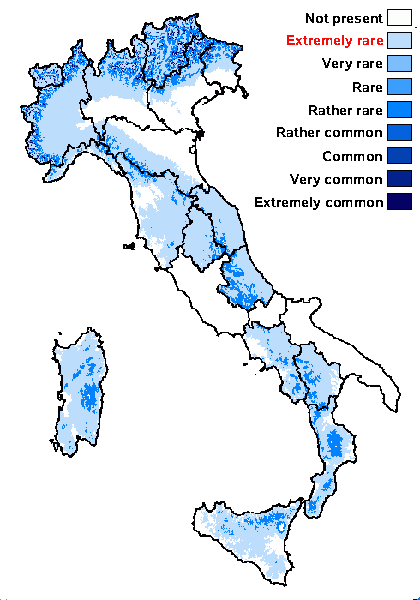
Predictive model
Herbarium samples
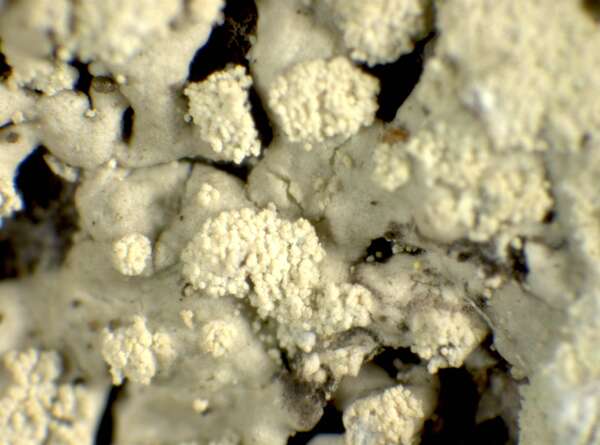

P.L. Nimis; Owner: Department of Life Sciences, University of Trieste
Herbarium: TSB (33030)
2001/12/10
soralia


P.L. Nimis; Owner: Department of Life Sciences, University of Trieste
Italy, Friuli Venezia Giulia, Udine, Passo del Pura, Ampezzo Carnico, 1400 m
09.09.2016
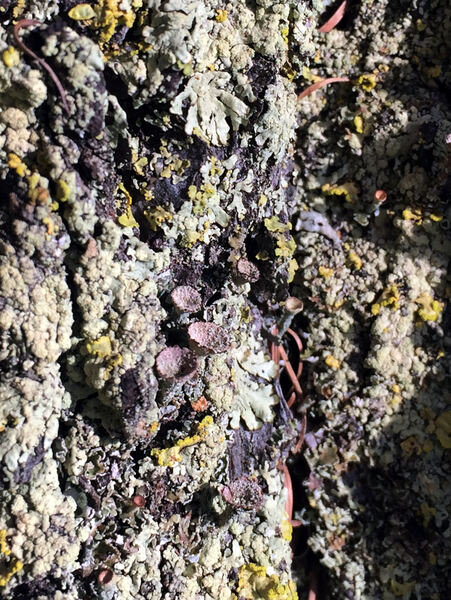

P.L. Nimis; Owner: Department of Life Sciences, University of Trieste
Italy, Friuli Venezia Giulia, Udine, Passo del Pura, Ampezzo Carnico, 1400 m
09.09.2016
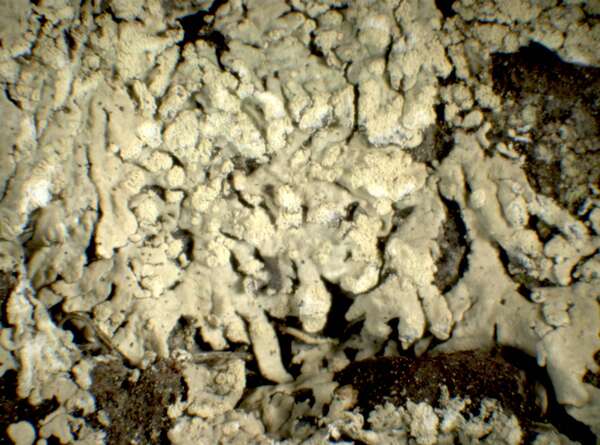

P.L. Nimis; Owner: Department of Life Sciences, University of Trieste
Herbarium: TSB (33030)
2001/12/10
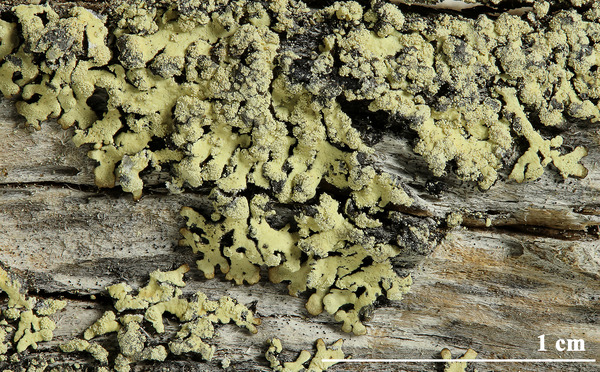

Felix Schumm - CC BY-SA 4.0
[19110], Australia, Victoria, Pretty Valley, Alpine National Park, 18 km south-south-east of Mt. Beauty, 36°53' S, 147°14' E, 1600 m, growing on base of dead Eucalyptus in open Eucalyptus pauciflora woodland with large granite outcrops. Leg. J.A. Elix (40630) & H. Streimann 18.02.1994.
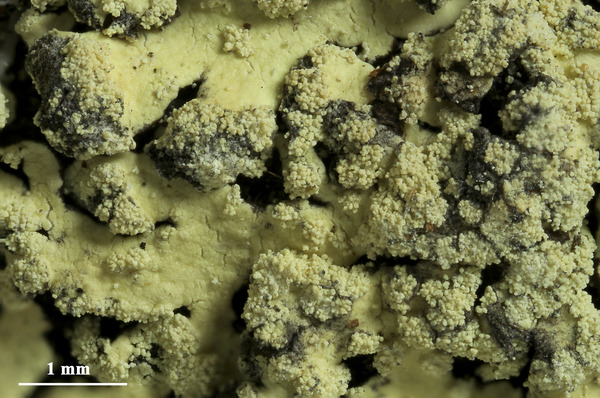

Felix Schumm - CC BY-SA 4.0
[19110], Australia, Victoria, Pretty Valley, Alpine National Park, 18 km south-south-east of Mt. Beauty, 36°53' S, 147°14' E, 1600 m, growing on base of dead Eucalyptus in open Eucalyptus pauciflora woodland with large granite outcrops. Leg. J.A. Elix (40630) & H. Streimann 18.02.1994.
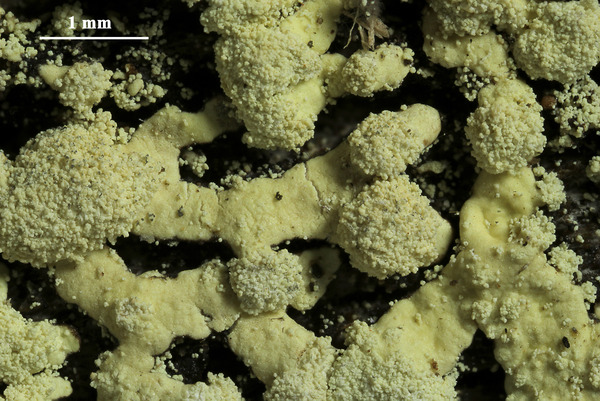

Felix Schumm - CC BY-SA 4.0
[19110], Australia, Victoria, Pretty Valley, Alpine National Park, 18 km south-south-east of Mt. Beauty, 36°53' S, 147°14' E, 1600 m, growing on base of dead Eucalyptus in open Eucalyptus pauciflora woodland with large granite outcrops. Leg. J.A. Elix (40630) & H. Streimann 18.02.1994.
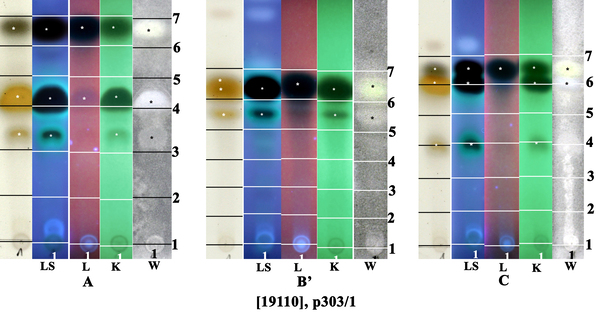

Felix Schumm - CC BY-SA 4.0
[19110], Australia, Victoria, Pretty Valley, Alpine National Park, 18 km south-south-east of Mt. Beauty, 36°53' S, 147°14' E, 1600 m, growing on base of dead Eucalyptus in open Eucalyptus pauciflora woodland with large granite outcrops. Leg. J.A. Elix (40630) & H. Streimann 18.02.1994.
us: usnic acid, div:divaricatic acid, nd: nordivaricatic acid
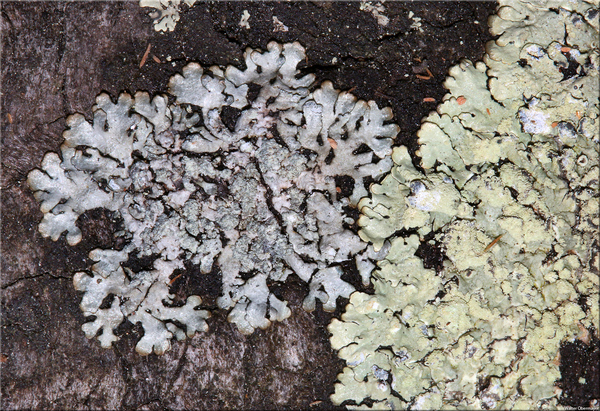
Walter Obermayer CC BY-SA 4.0 - Source: Lichens of Noricum - http://lichens-of-noricum.uni-graz.at/
with P. hyperopta (left)
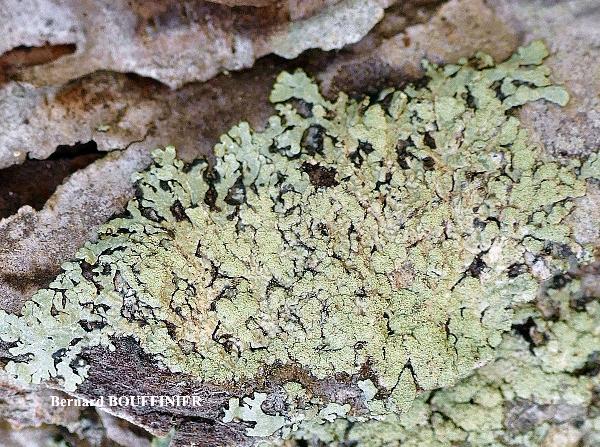
Bernard Bouffinier - Source: http://www.lichensmaritimes.org/index.php?task=fiche&lichen=746&lang=en
France, Corse, Soccia

Bernard Bouffinier - Source: http://www.lichensmaritimes.org/index.php?task=fiche&lichen=746&lang=en
France, Corse, Soccia
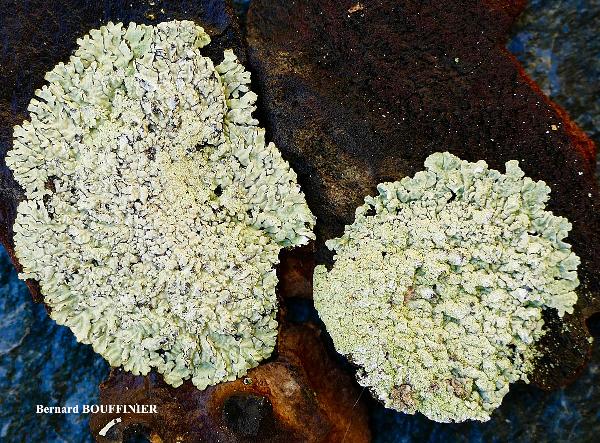
Bernard Bouffinier - Source: http://www.lichensmaritimes.org/index.php?task=fiche&lichen=746&lang=en
France, Corse, Soccia
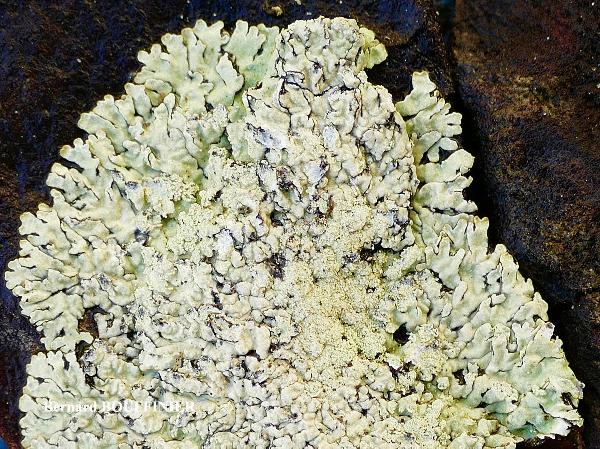
Bernard Bouffinier - Source: http://www.lichensmaritimes.org/index.php?task=fiche&lichen=746&lang=en
France, Corse, Soccia
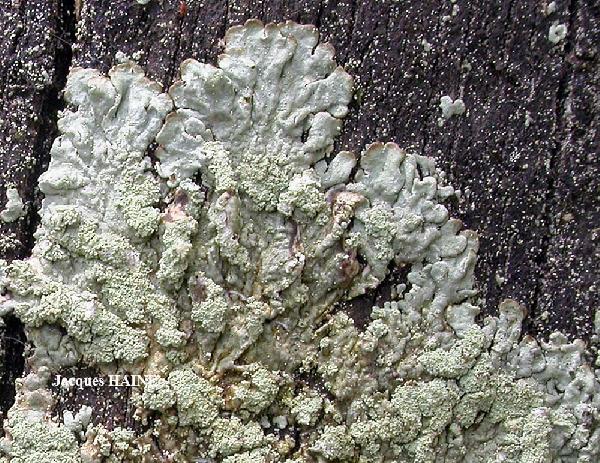
Jacques Haine - Source: http://www.lichensmaritimes.org/index.php?task=fiche&lichen=746&lang=en
France, Ardennes

Jacques Haine - Source: http://www.lichensmaritimes.org/index.php?task=fiche&lichen=746&lang=en
France, Ardennes
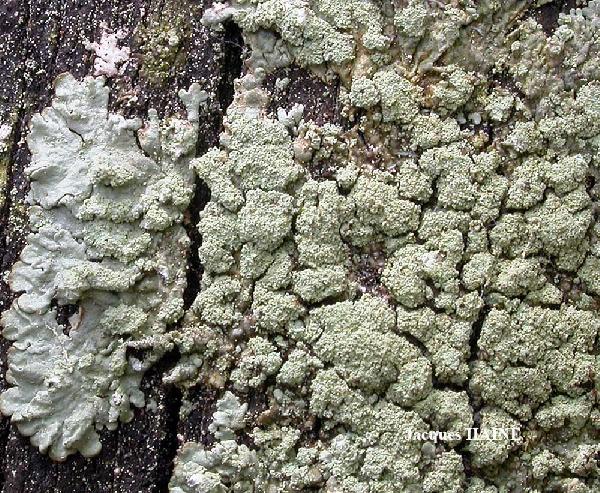
Jacques Haine - Source: http://www.lichensmaritimes.org/index.php?task=fiche&lichen=746&lang=en
France, Ardennes

Jacques Haine - Source: http://www.lichensmaritimes.org/index.php?task=fiche&lichen=746&lang=en
France, Mercantour
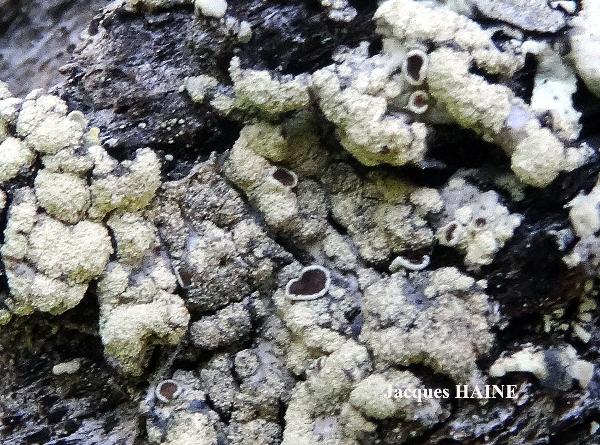
Jacques Haine - Source: http://www.lichensmaritimes.org/index.php?task=fiche&lichen=746&lang=en
France, Tarentaise
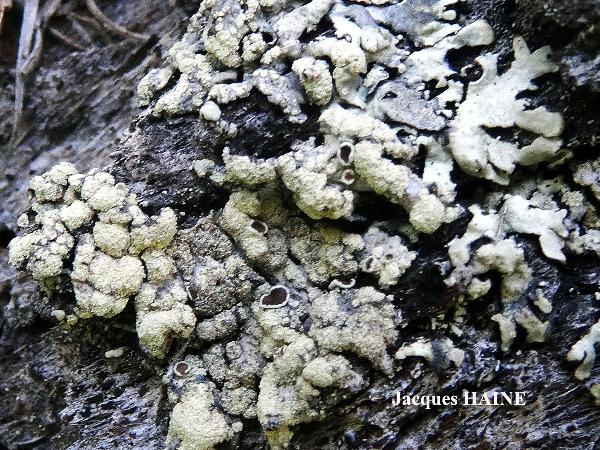
Jacques Haine - Source: http://www.lichensmaritimes.org/index.php?task=fiche&lichen=746&lang=en
France, Tarentaise
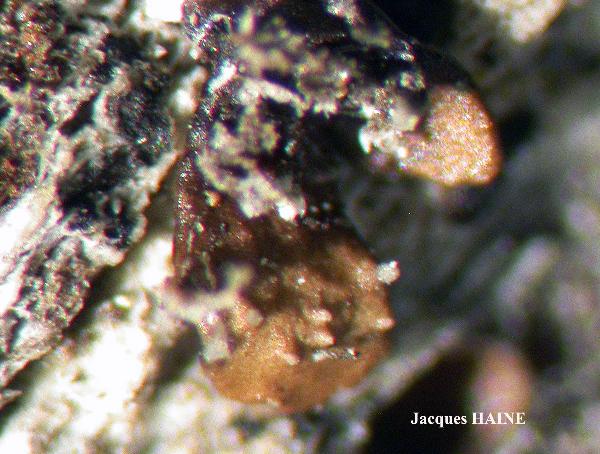
Jacques Haine - Source: http://www.lichensmaritimes.org/index.php?task=fiche&lichen=746&lang=en
France, Tarentaise
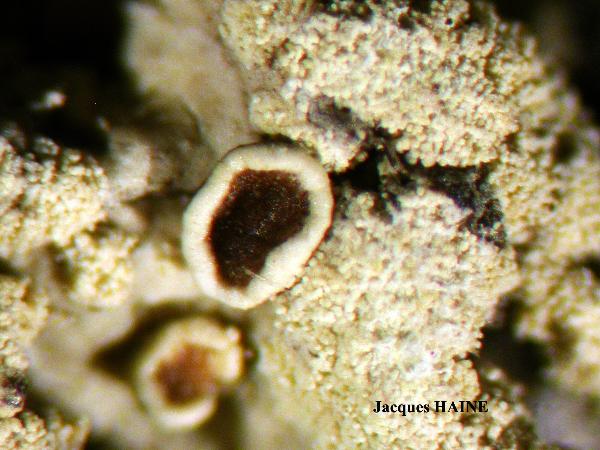
Jacques Haine - Source: http://www.lichensmaritimes.org/index.php?task=fiche&lichen=746&lang=en
France, Tarentaise

Jacques Haine - Source: http://www.lichensmaritimes.org/index.php?task=fiche&lichen=746&lang=en
France, Tarentaise
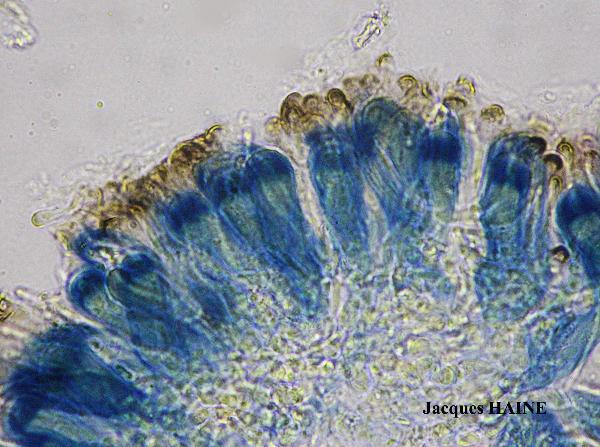
Jacques Haine - Source: http://www.lichensmaritimes.org/index.php?task=fiche&lichen=746&lang=en
France, Tarentaise
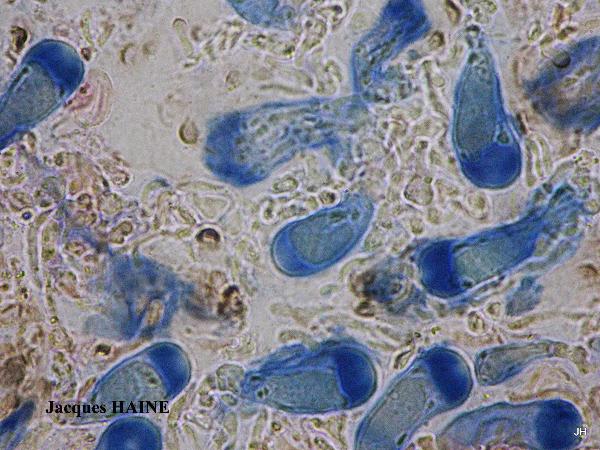
Jacques Haine - Source: http://www.lichensmaritimes.org/index.php?task=fiche&lichen=746&lang=en
France, Tarentaise
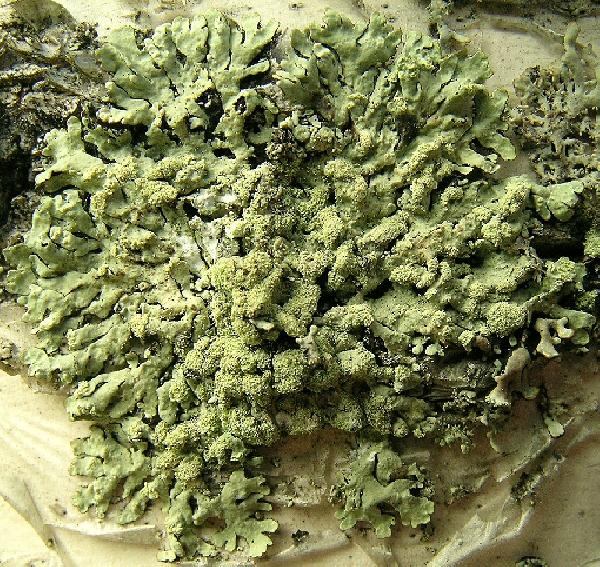
Ulrich Kirschbaum CC BY-SA 4.0 - Source: https://www.thm.de/lse/ulrich-kirschbaum/flechtenbilder
Central Europe.

Ulrich Kirschbaum CC BY-SA 4.0 - Source: https://www.thm.de/lse/ulrich-kirschbaum/flechtenbilder
Central Europe.
Growth form: Foliose, narrow lobed
Substrata: bark
Photobiont: green algae other than Trentepohlia
Reproductive strategy: mainly asexual, by soredia, or soredia-like structures (e.g. blastidia)
Commonnes-rarity: (info)
Alpine belt: extremely rare
Subalpine belt: extremely common
Oromediterranean belt: absent
Montane belt: rather rare
Submediterranean belt: extremely rare
Padanian area: absent
Humid submediterranean belt: extremely rare
Humid mediterranean belt: absent
Dry mediterranean belt: absent

Predictive model
| Herbarium samples |


P.L. Nimis; Owner: Department of Life Sciences, University of Trieste
Herbarium: TSB (33030)
2001/12/10
soralia


P.L. Nimis; Owner: Department of Life Sciences, University of Trieste
Italy, Friuli Venezia Giulia, Udine, Passo del Pura, Ampezzo Carnico, 1400 m
09.09.2016


P.L. Nimis; Owner: Department of Life Sciences, University of Trieste
Italy, Friuli Venezia Giulia, Udine, Passo del Pura, Ampezzo Carnico, 1400 m
09.09.2016


P.L. Nimis; Owner: Department of Life Sciences, University of Trieste
Herbarium: TSB (33030)
2001/12/10


Felix Schumm - CC BY-SA 4.0
[19110], Australia, Victoria, Pretty Valley, Alpine National Park, 18 km south-south-east of Mt. Beauty, 36°53' S, 147°14' E, 1600 m, growing on base of dead Eucalyptus in open Eucalyptus pauciflora woodland with large granite outcrops. Leg. J.A. Elix (40630) & H. Streimann 18.02.1994.


Felix Schumm - CC BY-SA 4.0
[19110], Australia, Victoria, Pretty Valley, Alpine National Park, 18 km south-south-east of Mt. Beauty, 36°53' S, 147°14' E, 1600 m, growing on base of dead Eucalyptus in open Eucalyptus pauciflora woodland with large granite outcrops. Leg. J.A. Elix (40630) & H. Streimann 18.02.1994.


Felix Schumm - CC BY-SA 4.0
[19110], Australia, Victoria, Pretty Valley, Alpine National Park, 18 km south-south-east of Mt. Beauty, 36°53' S, 147°14' E, 1600 m, growing on base of dead Eucalyptus in open Eucalyptus pauciflora woodland with large granite outcrops. Leg. J.A. Elix (40630) & H. Streimann 18.02.1994.


Felix Schumm - CC BY-SA 4.0
[19110], Australia, Victoria, Pretty Valley, Alpine National Park, 18 km south-south-east of Mt. Beauty, 36°53' S, 147°14' E, 1600 m, growing on base of dead Eucalyptus in open Eucalyptus pauciflora woodland with large granite outcrops. Leg. J.A. Elix (40630) & H. Streimann 18.02.1994.
us: usnic acid, div:divaricatic acid, nd: nordivaricatic acid

Walter Obermayer CC BY-SA 4.0 - Source: Lichens of Noricum - http://lichens-of-noricum.uni-graz.at/
with P. hyperopta (left)

Bernard Bouffinier - Source: http://www.lichensmaritimes.org/index.php?task=fiche&lichen=746&lang=en
France, Corse, Soccia

Bernard Bouffinier - Source: http://www.lichensmaritimes.org/index.php?task=fiche&lichen=746&lang=en
France, Corse, Soccia

Bernard Bouffinier - Source: http://www.lichensmaritimes.org/index.php?task=fiche&lichen=746&lang=en
France, Corse, Soccia

Bernard Bouffinier - Source: http://www.lichensmaritimes.org/index.php?task=fiche&lichen=746&lang=en
France, Corse, Soccia

Jacques Haine - Source: http://www.lichensmaritimes.org/index.php?task=fiche&lichen=746&lang=en
France, Ardennes

Jacques Haine - Source: http://www.lichensmaritimes.org/index.php?task=fiche&lichen=746&lang=en
France, Ardennes

Jacques Haine - Source: http://www.lichensmaritimes.org/index.php?task=fiche&lichen=746&lang=en
France, Ardennes

Jacques Haine - Source: http://www.lichensmaritimes.org/index.php?task=fiche&lichen=746&lang=en
France, Mercantour

Jacques Haine - Source: http://www.lichensmaritimes.org/index.php?task=fiche&lichen=746&lang=en
France, Tarentaise

Jacques Haine - Source: http://www.lichensmaritimes.org/index.php?task=fiche&lichen=746&lang=en
France, Tarentaise

Jacques Haine - Source: http://www.lichensmaritimes.org/index.php?task=fiche&lichen=746&lang=en
France, Tarentaise

Jacques Haine - Source: http://www.lichensmaritimes.org/index.php?task=fiche&lichen=746&lang=en
France, Tarentaise

Jacques Haine - Source: http://www.lichensmaritimes.org/index.php?task=fiche&lichen=746&lang=en
France, Tarentaise

Jacques Haine - Source: http://www.lichensmaritimes.org/index.php?task=fiche&lichen=746&lang=en
France, Tarentaise

Jacques Haine - Source: http://www.lichensmaritimes.org/index.php?task=fiche&lichen=746&lang=en
France, Tarentaise

Ulrich Kirschbaum CC BY-SA 4.0 - Source: https://www.thm.de/lse/ulrich-kirschbaum/flechtenbilder
Central Europe.

 INDEX FUNGORUM
INDEX FUNGORUM
 GBIF
GBIF
 DOLICHENS
DOLICHENS
